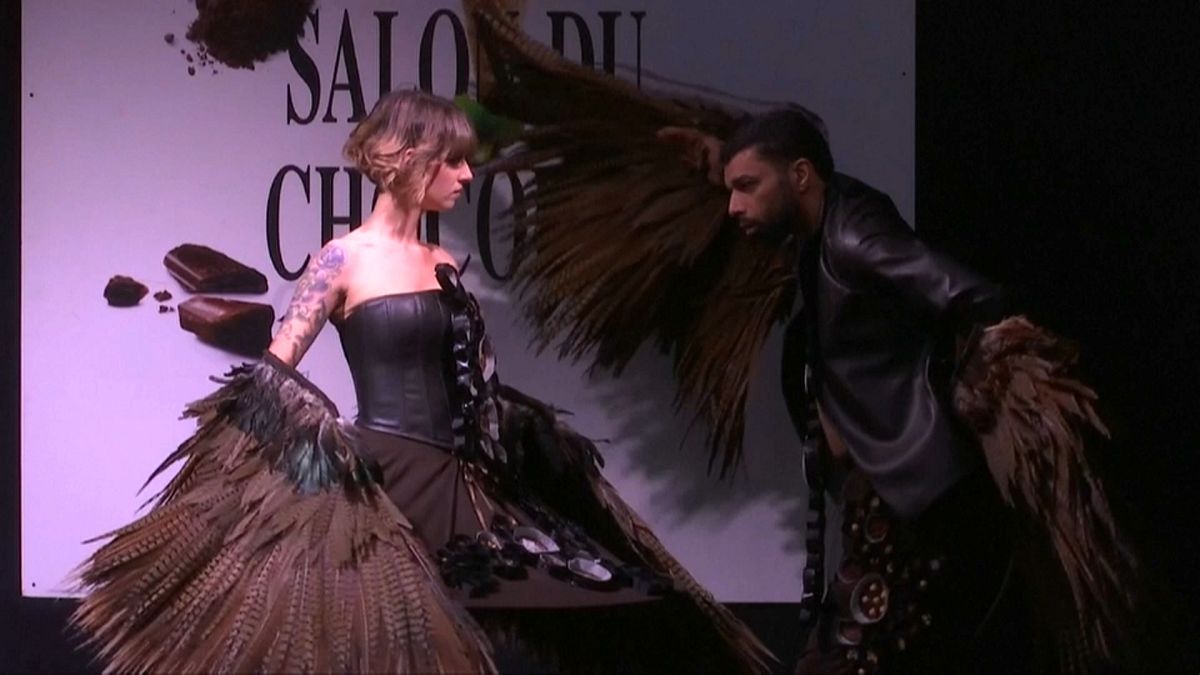One creation used 8kg of chocolate – not far off the 6kg the average Belgian eats in a year.
Chocolatiers and fashion designers have collaborated to bring dresses made of chocolate to a Brussels catwalk.
One creation, by designer Giovanni Biasiolo and chocolate maker Jean-Christophe Hubert, used 8kg of chocolate – not far off the 6kg the average Belgian eats in a year – while another, by Peruvian Ricardo Davila, featured a staff and headdress, also made of chocolate.
The dresses are part of a showcase by more than 70 artisans of trends in the country's chocolate industry, which is worth €4 billion a year and employs 9% of the population.
Belgium's chocolate history dates back to 1635, when the country was under occupation by Spain, which had recently brought chocolate to Europe from Central America.
Today the industry is not only a major component of the Belgian economy – production amounts to 662,000 tonnes per year, of which 578,000 tonnes are exported, with 330 chocolate companies in the country and more than 2,000 shops – but also an integral part of the national identity, in a country that is linguistically and socially divided.
Belgium, which has only existed in its current form since 1830, is also a country of economic disparities, with wealthy Flemish-speaking Flanders in the north dominating (due in large part to its ports and farmlands) over post-industrial, French-speaking Wallonia to the south, and a small German-speaking enclave to the east.
The country's world-famous foodstuffs (chocolate, waffles, fries and beer) are often said to be the only thing – besides its national football team the Red Devils, currently riding high after reaching the 2018 World Cup semi-finals – that unites it.
But the chocolate industry is undergoing something of an identity crisis itself, due to the number of "Belgian chocolate" companies now owned by foreign investors. When Galler was bought by the Qatari royal family last year, Flemish newspaper Het Nieuwsblad asked: “How Belgian is Belgian chocolate, if just about all the top players are in foreign hands?”
Guylian, founded in 1958, is now owned by South Korean conglomerate Lotte and Chocolat Jacques, founded in 1896, is in the hands of Dutch company Baronie. Belgium's biggest high street/supermarket chocolate brand Côte-d’Or, founded in 1883, belongs to the multinational Mondelēz. Its best-known luxury brand Godiva was bought by Turkish Yıldız Holding in 2007 from America's Campbell Soup Company, who purchased it in 1966.
By contrast, the 105-year-old high-end maker Leonidas was started by Greek-American Leonidas Kestekides in Brussels and is now being run by the third generation of his family and states proudly that it is "100% Belgian".
Belgian chocolate by numbers
The Belgian chocolate industry is worth €4bn a year
It employs 9% of the population
The average Belgian eats 6kg of chocolate in a year
Production amounts to 662,000 tonnes per year, of which 578,000 tonnes are exported
There are 330 chocolate companies in the country and more than 2,000 chocolate shops
190,000 tonnes of raw cacao arrive at the port of Antwerp annually
The world's biggest chocolate factory is Barry Callebaut in Wieze, which produces 300,000 tonnes per year
